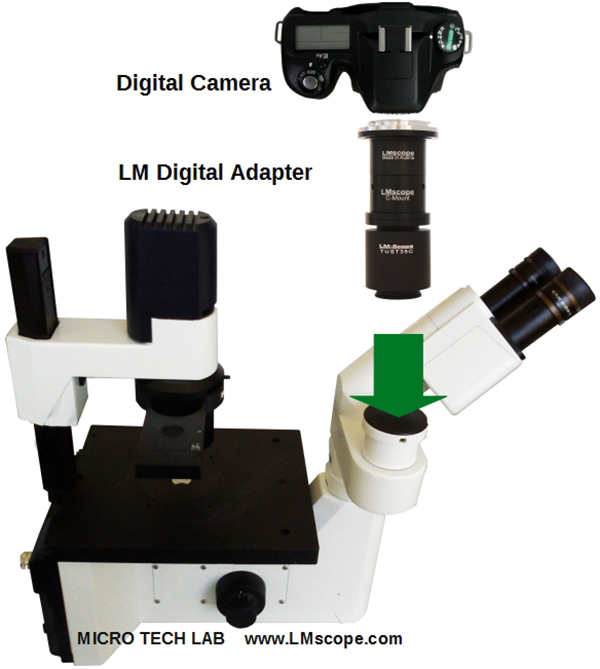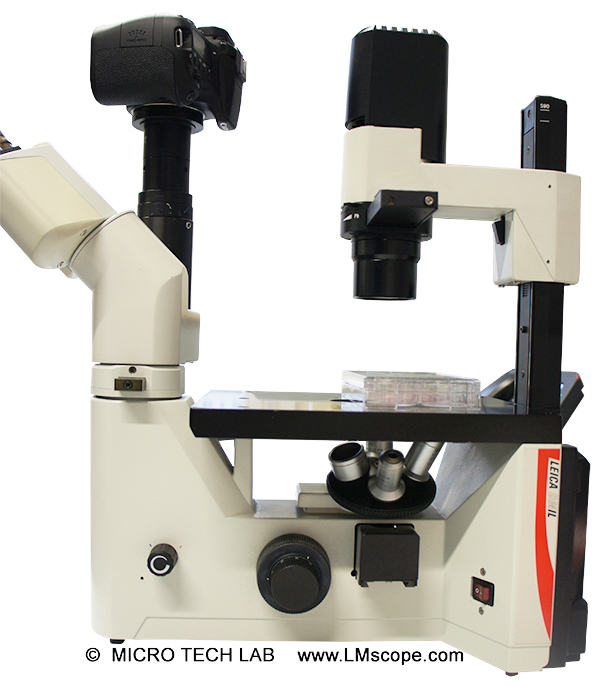

The Leica DM IL: an inverted microscope that excels in many areas
Leica’s infinity-corrected DM IL inverted research microscope, which hit the market in 1998, was intended primarily for routine examinations of cell and tissue cultures, liquids and sediments. Our LM digital adapters can be attached to this microscope quickly and easily to produce photographs of exceptional image quality. This combination makes it simple to achieve digital photo documentation using state-of-the-art camera technology.
Two basic stands are available: one is the standard bright field version using the contrasting methods bright field, phase contrast and integrated modulation contrast; the other is the fluorescence stand which also offers three transmitted light contrasting techniques as well as incident light fluorescence. Owing to the low centre of gravity of these stands, they are exceptionally stable, a characteristic that can be enhanced further in photomicrography applications by using an additional stabilisation plate.
Beyond the binocular tube and an ergo module, a trinocular tube is available as well. That tube offers an additional documentation output for taking photographs (switchable to direct 100% of the light either to the eyepieces or the photo port). With our LM digital adapters, almost any DSLR or system camera can be attached to the microscope.

The viewing angle of the DM IL is 45º. Its tube has an adjustable eyepiece holder that allows a field number of 20. If intermediate tubes (such as the multi-discussion facility) are used, that field number is limited to 18. The optical axis of the documentation port is offset to the left by 88 mm to ensure a free view of the specimen when using this tube. The photo tube viewed from above:

Leica’s DM IL has an integrated lamp housing equipped with a 6 volt/35 watt halogen bulb. However, 12 volt/100 watt lamp housings are also available.
Objectives are pivotal to ensuring quality images, and the Leica DM IL is equipped with a four-position objective turret. All microscope objectives with magnifications of 2.5 to 100 can be used. Leica also offers a wide range of objectives that deliver images of outstanding quality.
Conclusion:
When suitable objectives are used, Leica’s DM IL is an excellent microscope for use in photomicrography.
Photography:
Fitting the microscope to digital single-lens reflex (DSLR), mirrorless interchangeable-lens cameras (MILC ), digital single-lens mirrorless (DSLM) or C-mount cameras is easy with our LM digital SLR adapters, which feature a plan achromatic optical system. Our products make it possible to capture top-quality microscope images. To help you select the adapter that is right for your camera, we have set up an online configurator on our website. You can also email us – ideally with attached photographs of your microscope.
Modern DSLR and single-lens mirrorless (DSLM) offer the latest technology and are generally very well suited for microscopy applications. Most of them can be controlled remotely via PC/Mac. Because of their high sales volumes, they offer an excellent price/performance ratio compared to special-purpose microscope cameras.
Features of top DSLR and single-lens mirrorless cameras (DSLM):
- Large, powerful full-frame sensors (36 x 24 mm)
- Sensor resolution of 61 megapixels or 240 megapixels with Pixel Shift technology
- High light sensitivity (ISO 400,000+)
- Extensive dynamic range (up to 15 aperture stops/f-stops)
- Short exposure times (1/8000 second) up to 1/32,000 seconds using the digital shutter
- 4K Ultra HD or 8K Ultra HD video function
- Live video capture on external monitors in ultra HD quality
In most cases, these cameras are significantly more powerful than microscope cameras with smaller sensors (1/2" or 2/3"). On our website you will find our current camera recommendations and a camera ranking which is specifically tailored to microscopy applications.
New LM Digital Adapter for: Sony Alpha 9 III / Nikon Z9 / Nikon Z8 / Sony Alpha 7R V / Sony Alpha 1 II / Sony Alpha 1 / Sony Alpha 9 II (ILCE-9M2) / Sony FX3 Cinema Line / Sony Alpha 9 / Nikon D6 / Canon EOS R3 / Canon EOS R6 Mark II / Canon EOS R8 / Sony Alpha 7R IV / Canon EOS R5 II / Nikon Z6III / Canon EOS R5 / Sony Alpha 7S II / Sony Alpha 7S III / Sony Alpha 7R III / Canon EOS R6 / Nikon Z6 / Nikon Z6II / Sony Alpha 7R II / Nikon Z7 / Nikon Z7II / Canon EOS R / Canon EOS Ra (Astro) / Nikon Z5 / Sony Alpha 7C / Canon EOS RP / Sony Alpha 7S / Canon EOS R7 / Leica SL2-S / Canon EOS R10 / Nikon Z50 II / Canon EOS 1D X Mark III / Nikon Z50 / Nikon Z30 / Nikon Z fc / Nikon D850 / Canon EOS 1D X Mark II / Nikon D780 / Olympus OM-1 / Sony Alpha 7III / Olympus OM-D E-M1 Mark III / Canon EOS R100 / Sony Alpha 6700 / Nikon D5 / Sony Alpha 6600 / Fujifilm X-H2S / Fujifilm X-S10 / Fujifilm X-E4 / Fujifilm X-Pro3 / Olympus OM-D E-M1X / Sony Alpha 6400 / Sony Alpha 6100 / Sony ZV-E10 / Canon EOS 1D X / Nikon D4s / Olympus OM-D E-M5 III / Canon EOS 90D / Canon EOS 5D Mark IV / Nikon D4 / Nikon D750 / Canon EOS 6D Mark II / Fujifilm X-T5 / Fujifilm X-T4 / Fujifilm X-T3 / Sony Alpha 6300 / Sony Alpha 6500 / Nikon D500 / Nikon D810 / Nikon D800 / Canon EOS M6 Mark II / Nikon D800E / Nikon Df / Panasonic Lumix DC-G9 / Nikon D610 / Nikon D600 / Canon EOS 250D / Canon EOS 850D / Rebel T8i / Canon EOS 6D / Sony Alpha 99 II (SLT-A99 II) / Canon EOS M200 / Canon EOS 5DS R ( without low-pass filter) / Olympus OM-D E-M1 Mark II / Canon EOS 80D / Canon EOS M50 Mark II / Canon EOS 5DS / Canon EOS M50 / Sony Alpha 77 II / Canon EOS 70D / Nikon D7200 / Pentax K-1 Mark II / Canon EOS 200D / Canon EOS 800D / Rebel T7i / Canon EOS 77D / Canon EOS 5D Mark III / Canon EOS 60D / Sony Alpha 7R /
